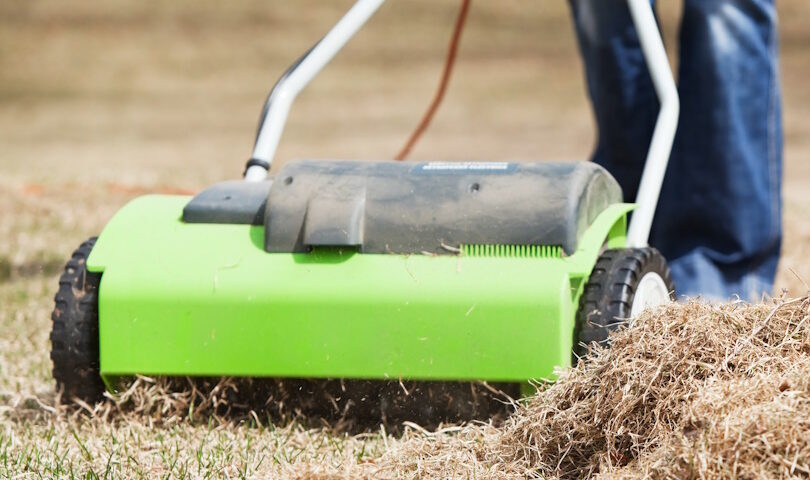Your lawn is a complex system, and Connecticut’s hot, humid summers can cause it to grow out of balance. If you’ve given your lawn all the water, nutrients, and sunlight it needs, but it’s still not as thick and lush as you’d like, consider what’s happening between your soil and the grass you mow each weekend. You could be suffering from an excess of thatch.
What is Thatch? Do I Need to Dethatch My Lawn?
Lawns in Connecticut naturally contain a good deal of dead material in the form of stems and roots. Most of the compounds in those materials, primarily cellulose, decompose and nourish your soil. Other compounds, lignans, resist decay and form a layer between the soil and the top of your lawn. We call that layer thatch.
A bit of thatch is a good thing, helping your lawn retain moisture and nutrients and protecting it from temperature swings. But anything more than half an inch or so can have the opposite effect, preventing water and nutrients from reaching your grass’s roots. Left unchecked, thatch can grow dense enough to prevent new blades of grass from pushing through, leaving you with unhealthy soil and a struggling, dingy-looking lawn.
How to Measure Your Thatch Levels
To check for signs that your lawn’s thatch has grown too thick, you don’t need any special equipment. You don’t even need to measure the thatch directly. If your lawn appears to be struggling and you suspect that excessive thatch is the culprit, just grab a screwdriver and insert it into the soil If you can’t push a screwdriver up to its handle with minimal effort, your lawn’s thatch has likely dried out what remains of your topsoil. If the screwdriver slides into the soil with little or no resistance, that can indicate a thatch problem, too. Some Connecticut soils drain poorly, and excessive thatch can prevent them from respirating, leaving them soggy, spongy, and bad for your lawn.
How to Get Rid of Connecticut Thatch
When you determine that your lawn’s thatch is too thick, it’s time for immediate action. After all, you just discovered that your lawn is either slowly starving or slowly drowning. Fortunately, you have your choice of three ways to effectively deal with excessive thatch.
- Manual raking. If you’re in position to do a bit of manual labor, a dethatching rake may be all you need. Your standard yard rake won’t do the trick: dethatching rakes have curved blades and short tines that are designed to get past your grass and down to your lawn’s thatch. This approach is roughly as strenuous as shoveling a few inches of snow, making it best for mild problems in smaller yards.
- Power rakes. What dethatching rakes are to yard rakes, power rakes are to your lawnmower. Power rakers work on the same basic principle as manual dethatching rakes, but with a motorized rotary blade. This approach trades convenience for nuance: you might not work up a sweat behind a power rake, but you also won’t be able to adjust the way it works over your lawn. Power rakes are best for heavier thatch in sturdy grass.
- While power rakes use the same rotary motion as your lawn mower, verticutters use a series of vertically rotating blades on a drum, something like a miniature harvester. These machines can clear thatch of any thickness, but they tend to do so at a cost to your existing lawn. If your thatch has grown especially thick, and you don’t mind having to reseed your lawn, a verticutter can quickly set the table for better, healthier things to come.
Each of these methods can be done by anyone, as long as they have the right tools. The more aggressive your dethatching job, though, the greater the chances that a DIY job will damage your lawn more than need be. If your thatch layer is too thick for a manual dethatching rake, it might be time to call a professional.
When to Dethatch Your Connecticut Lawn
Cool-season grasses like those used in most Connecticut landscaping designs tend to reach their peak annual growth in late summer into early fall. That’s when your grass is its strongest and its demands are the greatest. It’s also the perfect time to dethatch your lawn—and for some homeowners the only safe time to do so. For all its benefits, dethatching can be rough on your grass, and you might cause undue harm to your lawn and your soil if you dethatch at the wrong time.
Dethatching is often overlooked, but it can make the difference between a healthy, thriving lawn and a patchwork of green and brown. It is also somewhat invasive and disruptive. Even if you’re a committed DIYer, consider talking with a professional before you undertake your first big dethatching job.

